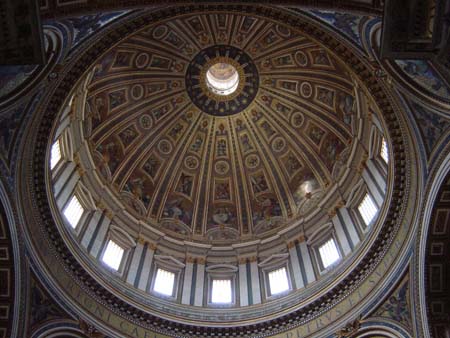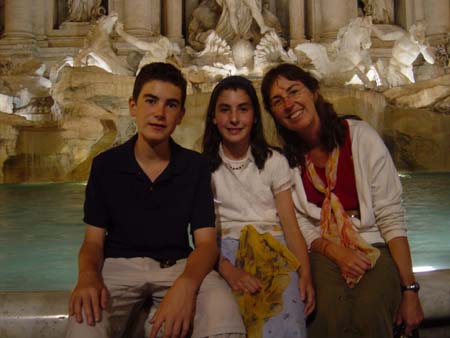Thursday, September 4
Steve: Our first day in Rome was very typical of our
first days in each new city that we visit. We always manage to see several
sites, do a lot of walking and get a pretty good feel for the layout and feel
of the city. However, things got started with a somewhat intimidating episode
on Rome's subway. We were scheduled for a 9:00 guided at the Vatican, and
thought that the subway (there's a stop only 5 minutes from our hotel) would
our best option for getting to St. Peter's. We knew we were in for an adventure
when we saw the hoards of people waiting on the platform, and especially when
the first train arrived already jammed with people. This didn't stop the people
who were waiting from literally forcing their way onto the train. We couldn't
believe how many people made it onto a train that already looked too full.
We watched a man go from door to door and pushing into the people, looking
for any way to squeeze on the train - while he did this, he held up the entire
subway from leaving (he eventually succeeded in getting on). We waited for
the next train, which was equally full. Fortunately, there weren't as many
people waiting to get on, so we did the shoving thing and made it. Once on
board, it was a scary feeling being crammed with so many people, and it was
not pleasant when several people got involved in a loud shouting match. Fortunately,
we found ourselves in the middle of a friendly group of English-speaking residents
and tourists, and we all successfully made fun of the situation. The residents
told us that this is typical for Rome's subway during the daytime hours. After
making it to our stop, we quickly all agreed that this would be our last experience
on Rome's subway (very strange for us, since the subway has been our primary
mode of transportation in so many places).
Paula and I had been to Rome in 1982, but had forgotten the tremendous beauty of St. Peter's square. St. Peter's Basilica stands magnificently at the end of the square and is flanked on either side by rows of columns arranged in an open and welcoming circle. Our guide provided insight into the square's captivating architecture by explaining how the columns and statutes were skillfully devised to promote harmony and symmetry. She also showed us how the rows of columns lined up perfectly from one point in the square so that it looked like there was just one row. The morning was crisp (22 degrees Celsius) and clear, and we enjoyed an initial walk through the square.

We met our guide and began with a tour of St. Peter's Basilica. The basilica
is huge and very impressive. Our guide gave us some very interesting insights
about the design, artwork and history of the basilica. We especially enjoyed
learning about many of the architectural "tricks" that were employed
by Michelangelo, Bramante, Raphael and others to create desired effects throughout
the basilica. Interestingly, there are no frescoes anywhere - they were all
removed and replaced with unbelievably intricate mosaic replicas. This has
become a whole new type of art in the Vatican. The artistic highlight of the
basilica is Michelangelo's Pieta, considered to be one of the most famous
and beautiful statues in the world. 
After St. Peter's, we had a brief lunch and then our tour continued with
a trip through the Vatican museum. Again, our guide took us to the highlights
of the museum and shared some fascinating stories. One particularly interesting
story involved the statue of Laocoon, which was discovered in 1506. It depicts
the Trojan priest of Apollo and his two sons fighting with sea serpents. When
discovered, several pieces were missing and a group of experts eventually
agreed on how the original must have looked.  Several
replicas were then developed. When Michelangelo saw the replicas, he concluded
that they could not have been accurate - they made the statue look awkward.
The "experts" disagreed and Michelangelo was ridiculed. Long after
the statue's discovery and Michelangelo's death, another piece of the statue
(the priest's elbow) was discovered, proving that Michelangelo was in fact
correct about the statue. This piece was attached, and the statue is displayed
in the Vatican along side a picture of the incorrect replica that had been
produced.
Several
replicas were then developed. When Michelangelo saw the replicas, he concluded
that they could not have been accurate - they made the statue look awkward.
The "experts" disagreed and Michelangelo was ridiculed. Long after
the statue's discovery and Michelangelo's death, another piece of the statue
(the priest's elbow) was discovered, proving that Michelangelo was in fact
correct about the statue. This piece was attached, and the statue is displayed
in the Vatican along side a picture of the incorrect replica that had been
produced.
The highlights of the Vatican Museum are Raphael's wall paintings (especially
"The School of Athens") and the Sistine Chapel. The Sistine Chapel
recently underwent an amazing 13-year restoration (completed in 1994) that
made a major change in the appearance of Michelangelo's paintings. Over the
years, the walls and ceilings had become increasingly dark, and the colors
of Michelangelo's works were very difficult to see. Over the 13 years, 400
people worked using a special method to systematically clean every square
inch of the chapel walls and ceiling (this compares with a total of 8 years
that Michelangelo himself spent painting the entire chapel!). The results
are spectacular. The colors are brilliant, and the beauty of the chapel is
overwhelming. Paula and I remember what it looked like in  1982,
and the change is unbelievable. Our guide explained that the restoration was
very controversial in Italy - many thought that the paintings should be left
dark.
1982,
and the change is unbelievable. Our guide explained that the restoration was
very controversial in Italy - many thought that the paintings should be left
dark.
David and Katie enjoyed learning about the Vatican, and the fact that it became the world's smallest independent state since 1929 when the Lateran treaty was signed by Mussolini. They have now added the Vatican to our growing list of "countries" that we've traveled to. We made our visit official by sending a postcard from the Vatican's post office.

Leaving the Vatican, we decided to walk through the center of the city, visiting some key sites along the way. We first walked to the Castel 'Sant Angelo, a fortress created for the Popes in the 6th century, AD. We walked to the top and got great views across Rome and into the surrounding countryside. From there, we walked to Piazza Navona, one of Rome's many squares. We enjoyed a quick snack of gelato, and then went to the nearby Pantheon, considered to be the best preserved building from ancient Rome. The dome is the largest masonry dome ever built, and is considered to be one of the most important architectural achievements of ancient Rome. Interestingly, Michelangelo designed the dome on St. Peter's to be one meter smaller than the Pantheon's in respect to the builder's of the Pantheon.
Finally, it was time for dinner and we enjoyed another evening of Italian
wine, bruschetta, and pasta. This may be a habit that becomes hard to break!

After dinner, we enjoyed a wonderful evening walk through Rome, stopping
to observe the sights (and traffic) in Piazza Venezia, and also the Fountain
of Trevi. David and Katie tossed coins over their shoulders to insure that
they return to Rome (this obviously worked for Paula and me when we tossed
coins back in 1982!). We completed our day with wonderful gelati at a place
called San Crispinos, considered by many to have the best gelati in Rome (they
prominently display a write-up from the New York Times at their front door).

Exhausted (but very satisfied), we took a taxi back to the hotel. Tomorrow, we plan on resting and catching up in the morning, and will then look forward to exploring the Roman Forum and Colosseum.
Distance Walked: 5.55 miles
